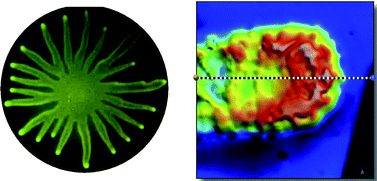Surface tension gradient control of bacterial swarming in colonies of Pseudomonas aeruginosa†
Abstract
Bacterial swarming is one of the most efficient methods by which bacteria colonize

* Corresponding authors
a Centre of Microbial and Plant Genetics, Katholieke Universiteit Leuven, Leuven, Belgium
b
Department of Chemical Engineering, Katholieke Universiteit Leuven, Leuven, Belgium
E-mail:
jan.vermant@cit.kuleuven.be
c Department of Metallurgy and Materials Engineering, Katholieke Universiteit Leuven, Leuven, Belgium
Bacterial swarming is one of the most efficient methods by which bacteria colonize

 Please wait while we load your content...
Something went wrong. Try again?
Please wait while we load your content...
Something went wrong. Try again?
M. Fauvart, P. Phillips, D. Bachaspatimayum, N. Verstraeten, J. Fransaer, J. Michiels and J. Vermant, Soft Matter, 2012, 8, 70 DOI: 10.1039/C1SM06002C
To request permission to reproduce material from this article, please go to the Copyright Clearance Center request page.
If you are an author contributing to an RSC publication, you do not need to request permission provided correct acknowledgement is given.
If you are the author of this article, you do not need to request permission to reproduce figures and diagrams provided correct acknowledgement is given. If you want to reproduce the whole article in a third-party publication (excluding your thesis/dissertation for which permission is not required) please go to the Copyright Clearance Center request page.
Read more about how to correctly acknowledge RSC content.
 Fetching data from CrossRef.
Fetching data from CrossRef.
This may take some time to load.
Loading related content
